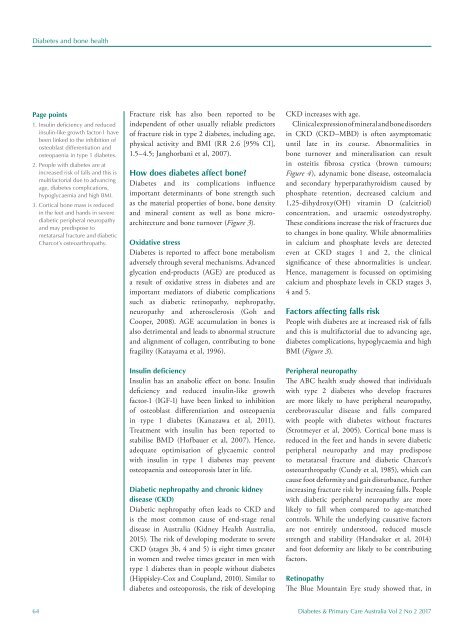DPCA2-2_issue
Create successful ePaper yourself
Turn your PDF publications into a flip-book with our unique Google optimized e-Paper software.
Diabetes and bone health<br />
Page points<br />
1. Insulin deficiency and reduced<br />
insulin-like growth factor-1 have<br />
been linked to the inhibition of<br />
osteoblast differentiation and<br />
osteopaenia in type 1 diabetes.<br />
2. People with diabetes are at<br />
increased risk of falls and this is<br />
multifactorial due to advancing<br />
age, diabetes complications,<br />
hypoglycaemia and high BMI.<br />
3. Cortical bone mass is reduced<br />
in the feet and hands in severe<br />
diabetic peripheral neuropathy<br />
and may predispose to<br />
metatarsal fracture and diabetic<br />
Charcot’s osteoarthropathy.<br />
Fracture risk has also been reported to be<br />
independent of other usually reliable predictors<br />
of fracture risk in type 2 diabetes, including age,<br />
physical activity and BMI (RR 2.6 [95% CI],<br />
1.5–4.5; Janghorbani et al, 2007).<br />
How does diabetes affect bone?<br />
Diabetes and its complications influence<br />
important determinants of bone strength such<br />
as the material properties of bone, bone density<br />
and mineral content as well as bone microarchitecture<br />
and bone turnover (Figure 3).<br />
Oxidative stress<br />
Diabetes is reported to affect bone metabolism<br />
adversely through several mechanisms. Advanced<br />
glycation end-products (AGE) are produced as<br />
a result of oxidative stress in diabetes and are<br />
important mediators of diabetic complications<br />
such as diabetic retinopathy, nephropathy,<br />
neuropathy and atherosclerosis (Goh and<br />
Cooper, 2008). AGE accumulation in bones is<br />
also detrimental and leads to abnormal structure<br />
and alignment of collagen, contributing to bone<br />
fragility (Katayama et al, 1996).<br />
Insulin deficiency<br />
Insulin has an anabolic effect on bone. Insulin<br />
deficiency and reduced insulin-like growth<br />
factor-1 (IGF-1) have been linked to inhibition<br />
of osteoblast differentiation and osteopaenia<br />
in type 1 diabetes (Kanazawa et al, 2011).<br />
Treatment with insulin has been reported to<br />
stabilise BMD (Hofbauer et al, 2007). Hence,<br />
adequate optimisation of glycaemic control<br />
with insulin in type 1 diabetes may prevent<br />
osteopaenia and osteoporosis later in life.<br />
Diabetic nephropathy and chronic kidney<br />
disease (CKD)<br />
Diabetic nephropathy often leads to CKD and<br />
is the most common cause of end-stage renal<br />
disease in Australia (Kidney Health Australia,<br />
2015). The risk of developing moderate to severe<br />
CKD (stages 3b, 4 and 5) is eight times greater<br />
in women and twelve times greater in men with<br />
type 1 diabetes than in people without diabetes<br />
(Hippisley-Cox and Coupland, 2010). Similar to<br />
diabetes and osteoporosis, the risk of developing<br />
CKD increases with age.<br />
Clinical expression of mineral and bone disorders<br />
in CKD (CKD–MBD) is often asymptomatic<br />
until late in its course. Abnormalities in<br />
bone turnover and mineralisation can result<br />
in osteitis fibrosa cystica (brown tumours;<br />
Figure 4), adynamic bone disease, osteomalacia<br />
and secondary hyperparathyroidism caused by<br />
phosphate retention, decreased calcium and<br />
1,25-dihydroxy(OH) vitamin D (calcitriol)<br />
concentration, and uraemic osteodystrophy.<br />
These conditions increase the risk of fractures due<br />
to changes in bone quality. While abnormalities<br />
in calcium and phosphate levels are detected<br />
even at CKD stages 1 and 2, the clinical<br />
significance of these abnormalities is unclear.<br />
Hence, management is focussed on optimising<br />
calcium and phosphate levels in CKD stages 3,<br />
4 and 5.<br />
Factors affecting falls risk<br />
People with diabetes are at increased risk of falls<br />
and this is multifactorial due to advancing age,<br />
diabetes complications, hypoglycaemia and high<br />
BMI (Figure 3).<br />
Peripheral neuropathy<br />
The ABC health study showed that individuals<br />
with type 2 diabetes who develop fractures<br />
are more likely to have peripheral neuropathy,<br />
cerebrovascular disease and falls compared<br />
with people with diabetes without fractures<br />
(Strotmeyer et al, 2005). Cortical bone mass is<br />
reduced in the feet and hands in severe diabetic<br />
peripheral neuropathy and may predispose<br />
to metatarsal fracture and diabetic Charcot’s<br />
osteoarthropathy (Cundy et al, 1985), which can<br />
cause foot deformity and gait disturbance, further<br />
increasing fracture risk by increasing falls. People<br />
with diabetic peripheral neuropathy are more<br />
likely to fall when compared to age-matched<br />
controls. While the underlying causative factors<br />
are not entirely understood, reduced muscle<br />
strength and stability (Handsaker et al, 2014)<br />
and foot deformity are likely to be contributing<br />
factors.<br />
Retinopathy<br />
The Blue Mountain Eye study showed that, in<br />
64 Diabetes & Primary Care Australia Vol 2 No 2 2017
















